In a TEDx talk by Will Richardson entitled, The Surprising Truth About Learning in School, he posed the question, What do you believe about how children learn best? The list below on the left are answers various teachers, parents, and administrators gave Richardson to answer that question. The list on the right are the things we do in schools to achieve learning.
Safe environment Sitting in rows
Personal investment 45/60/88 minute blocks
Real world application One-sized curriculum
Fun One subject area focus
Relevance to their lives Age-grouped co-learners
Social No real world application
Interesting questions Teacher controlled
Positive environment Someone else’s questions
Real audience Standardized assessments
Passion Emphasis on grades
Teachers/Mentors Carrots and sticks
Autonomy and Agency No choice/No agency
Challenging Lack of relevance
Not time constrained “Handing it in”
The overall conclusion Richardson makes is that we need to put into practice those things that support what we believe. I am very much involved in the process and associate myself with people who are working to make relevant change in our schools. But this article is addressed to those of us who choose to homeschool our children. Richardson’s “surprising truth” is that schools weren’t built for learning, but the good news is that homes were created for learning! Children are born into families/homes and in the first three years of life, a whole lot of learning is going on from walking to talking to social interactions. Ideally, homes contain all of the traits listed on the left side above, including parents who love their children unconditionally and want the best for their children’s health and happiness.
We only know what we know, right? Most of us were schooled so that’s where we start and are most comfortable. But, if we always do what we’ve always done, we’ll get what we’ve always gotten. If you watch the above TEDx talk, you’ll see we’re failing on many levels from having the lowest SAT scores in ten years, to colleges saying less than 20% of students are prepared entering college or work, to overall unhappiness of students in finding schooling relevant. The reasons for these outcomes are directly related to the goals they aim to meet. Because there is government money involved, schools need to create measurable accountability. Thus, tests are measureable, grades are measurable, worksheets filled out are measurable. And, if things aren’t working, do everything sooner. Forget that we’re ignoring every piece of research evidence showing that sooner is not better.
So, what are the practices we can put into place in our homeschools that creates the optimal learning environment? First, we have to have goals that align with best learning practices. In other words, what do our goals need to be in order to have the majority of those traits listed on the left side be used? My goals were to achieve engagement and a love of learning. I wanted interconnected relationships through effective communication and emotional intelligence. Ultimately, I wanted my children to find their passion and to seek out their purpose in the world. If you look at the traits on the left side of the chart, my goals align with utilizing those better strategies in an optimal learning environment. Create your own goals that you can revisit again and again with which you can align your day-to-day activities and steer your homeschooling boat if it goes off course.
Second, what does learning look like when it doesn’t look like school and utilizes those left column attributes? Having some examples to help begin the shift are helpful. I would like to share a couple. I’ve been purging “stuff” from my life now that I’m at the latter-end of raising my children. As many long-time homeschoolers might be able to attest, one can collect a variety of schoolish things on our journey that might come from well-meaning family and friends or through the mail. I found one such resource (that I never used). It was activities a teacher can use to teach children after reading a book. One book was Charlotte’s Web. In other words, here are a bunch of ideas to (suck the fun out of a book) occupy children for a whole week of at least an hour a day with activities to send home (to prove we were doing something with our day through show-me-work).
We don’t have to fill our days with activities that will, well, fill our days, or to prove learning has happened. (How many of us can prove our parenting is working until they become adults?) Let’s compare what teacher-initiated learning (school think) looks like and what engaged learning looks like. Here’s the “pre-reading activities” page:
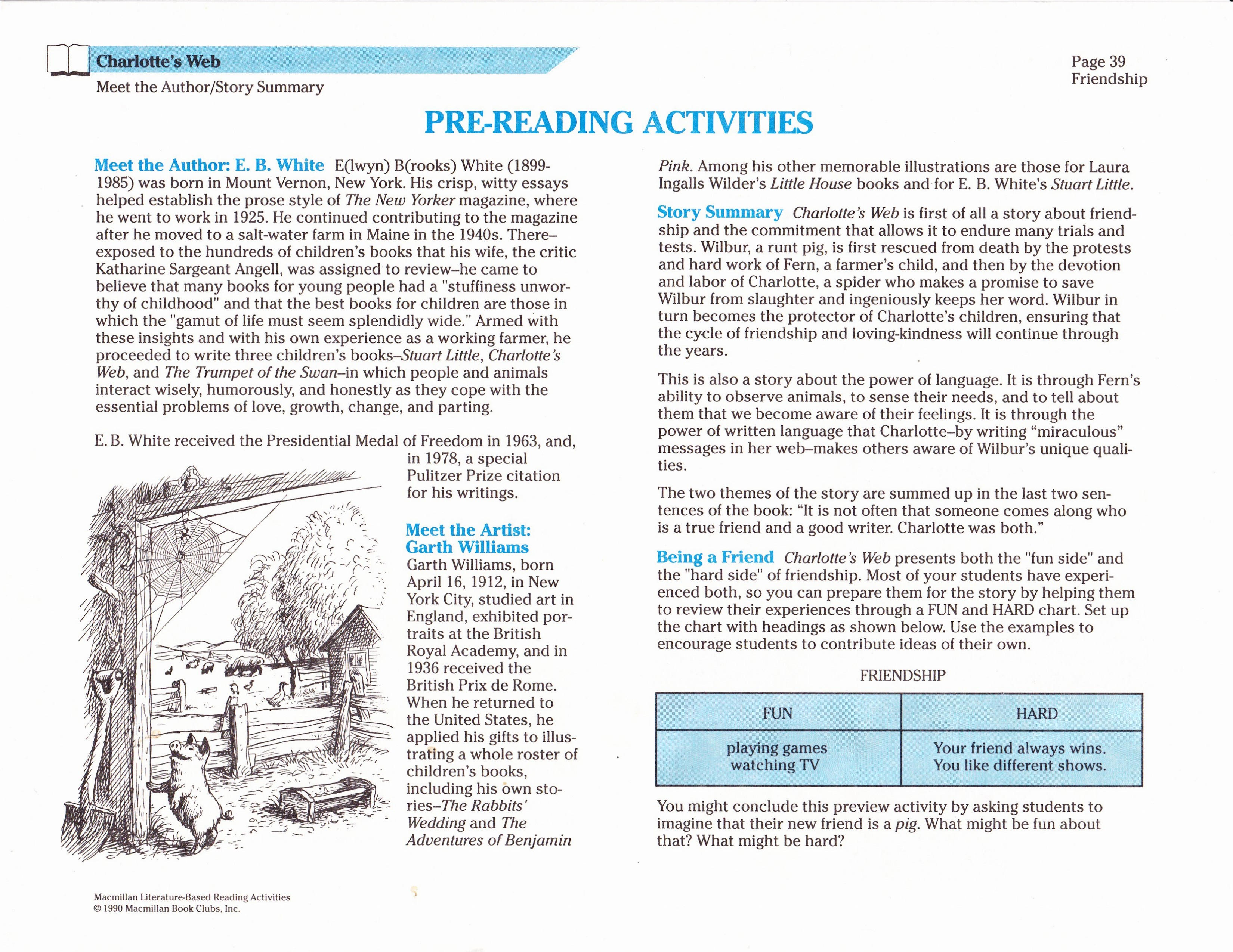
For the author and artist sections, simply by having books in the home for our children to look at and read (depending on their stage of learning), going to the library, and reading aloud to them, they will discover the definition of and interest in an author and an artist. This modeling through books can inspire them to write their own stories, tell their own stories, or draw their own pictures. That is far more engaging than rotely reading an excerpt about an author or artist over and over again.
The story summary leads a person to the conclusions and points to consider that are important to the person who created this resource. My children will be inspired from their own frame of reference. My  oldest son had a very strong fairness gene young and would have related to Fern’s outrage over her father’s decision to kill the runt. My daughter loves to commune with animals and would have connected with Fern’s propensity for hanging out with the animals more than wanting to hang out with the humans. These discussions and reactions happen naturally through personal conviction without steering them specifically. And navigating the art of friendships, through its fun and hard aspects, goes along with being a present social and emotional mentor.
oldest son had a very strong fairness gene young and would have related to Fern’s outrage over her father’s decision to kill the runt. My daughter loves to commune with animals and would have connected with Fern’s propensity for hanging out with the animals more than wanting to hang out with the humans. These discussions and reactions happen naturally through personal conviction without steering them specifically. And navigating the art of friendships, through its fun and hard aspects, goes along with being a present social and emotional mentor.
Overall, instead of these pre-planned activities, we’ve traded in sitting down to a lesson with a teacher with reading aloud and/or watching a movie together where we had discussions about what we were reading/viewing that were relevant to each individual child. We’ve added to their emotional intelligence and social acuity as we’ve mentored with them through friendship interactions with siblings or friends. No planning was necessary.
Here is the next page of ideas:
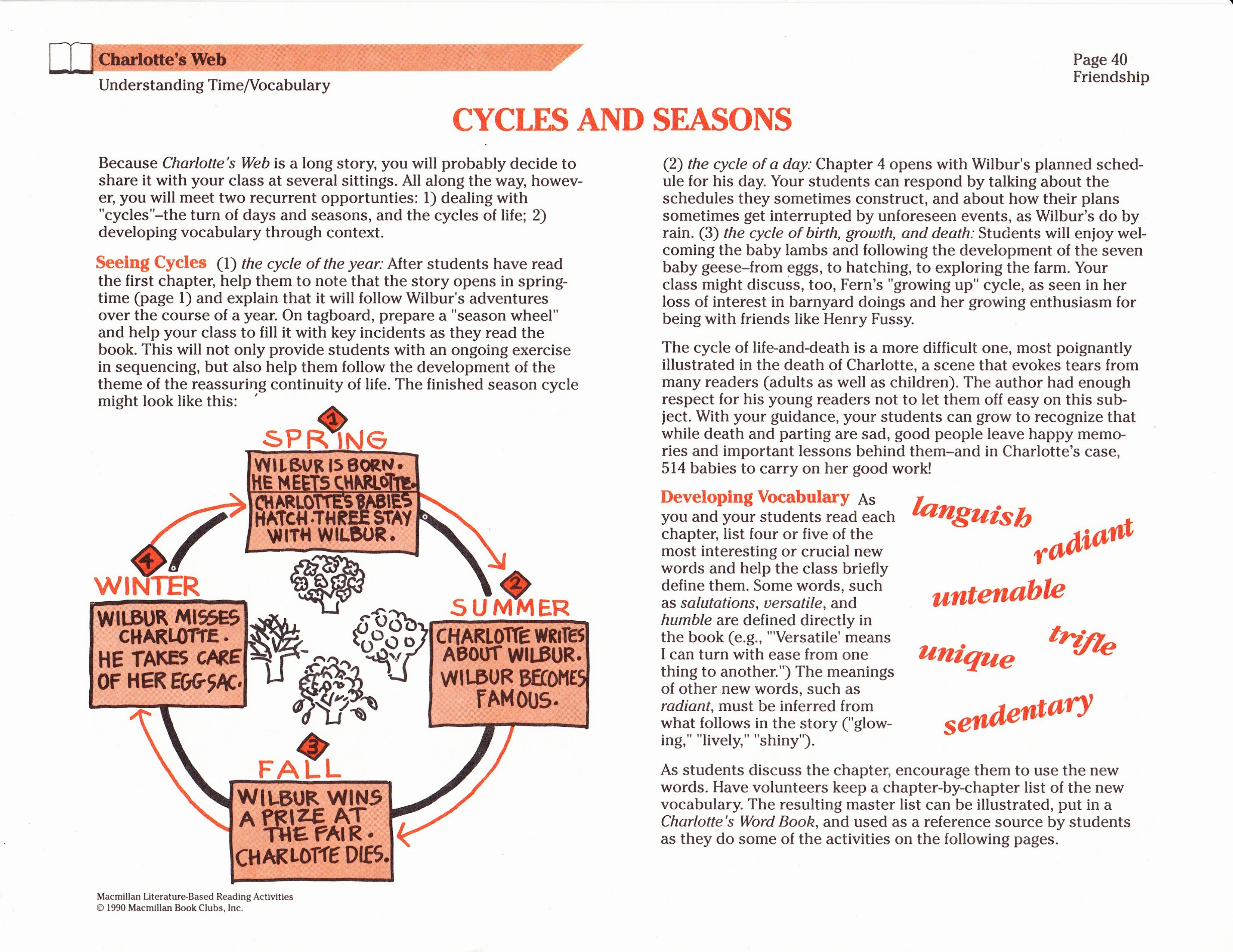
Because we are experiencing life together through all the seasons and all day, we don’t have to specifically have a “lesson” on these things. The rebirth found in spring, baby animals being born and hatching, and bugs beginning anew is a natural discussion point in a family. Autumn brings falling leaves, dormant stages, and a natural time to bring up end cycles that might include death. Whether through stories or living, life and death can be discussed through a place of relevance.
Overall, instead of these pre-planned activities, we’ve traded in talking about life cycles with scoring several hours of free time and exploration for your children outdoors and/or taking a nature hike.
Here are the first two worksheets around the topic of comprehension:
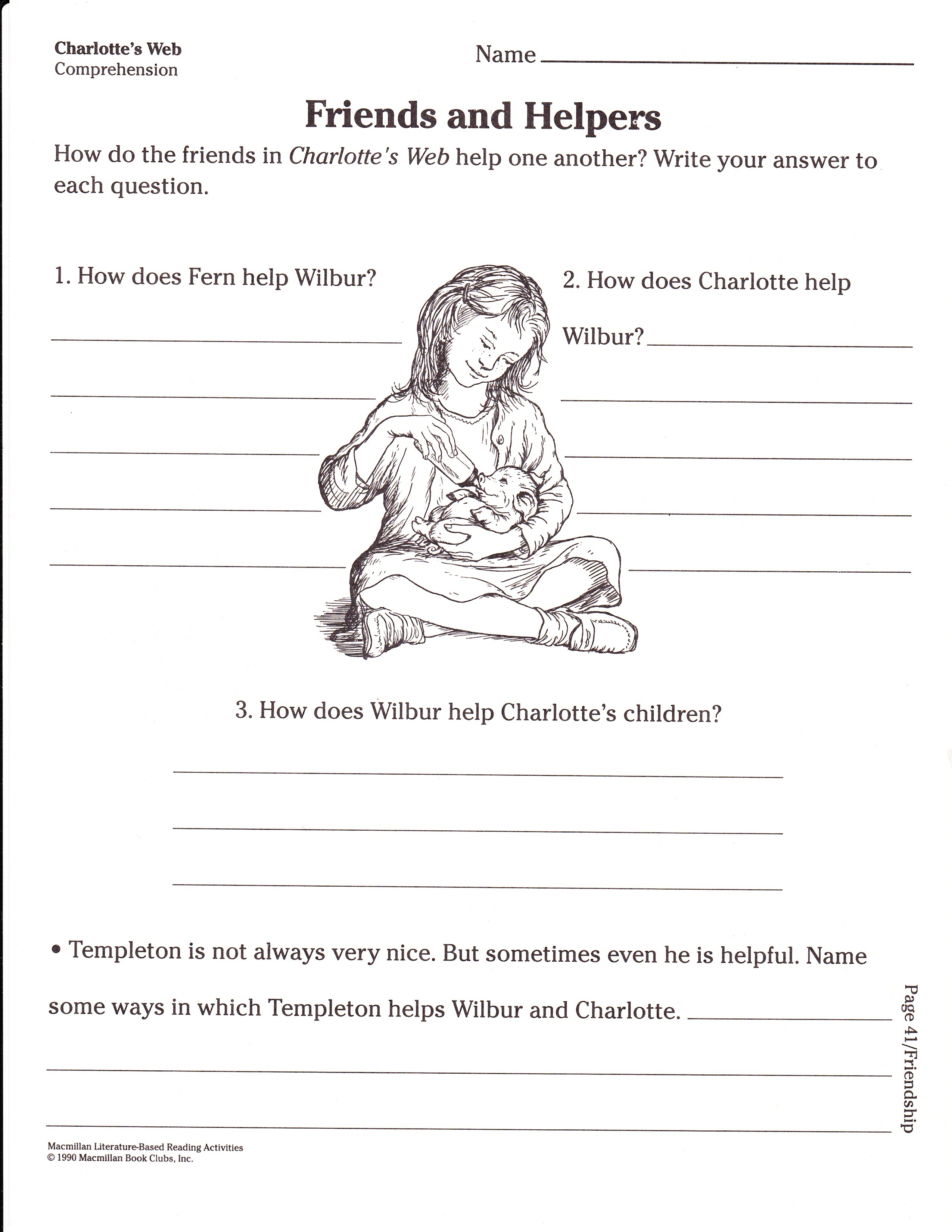
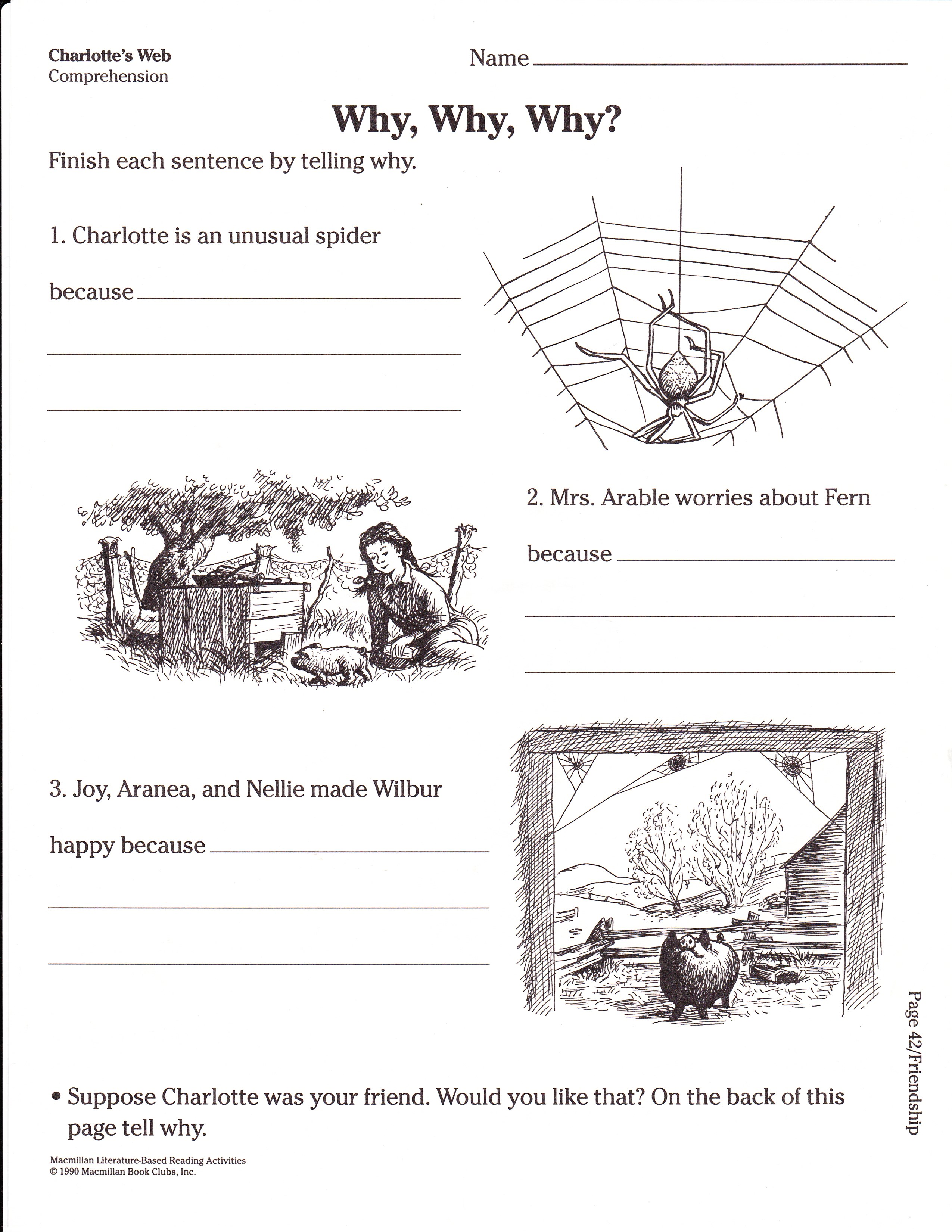
How do I know my children comprehended something? Because they often act on it. They may start to pretend they are the characters in the book or movie. They may have an interest in spiders now and pick  out books at the library about them. We might watch a documentary about spiders. They may start pointing out things in nature because they are paying more attention. We might notice all the spider webs now and discover we now feel like spiders are our friends instead of being afraid of them. The children may now insist that we save the spiders we find in the house instead of killing them because they might be Charlotte. This is real engagement and meaningful and far-reaching into their individual lives.
out books at the library about them. We might watch a documentary about spiders. They may start pointing out things in nature because they are paying more attention. We might notice all the spider webs now and discover we now feel like spiders are our friends instead of being afraid of them. The children may now insist that we save the spiders we find in the house instead of killing them because they might be Charlotte. This is real engagement and meaningful and far-reaching into their individual lives.
Overall, instead of these pre-planned activities, we’ve traded in filling out a worksheet with play time and/or my children drawing their own conclusions about something in their world as they personally interact with it.
Here are the next two worksheets around the topic of vocabulary:
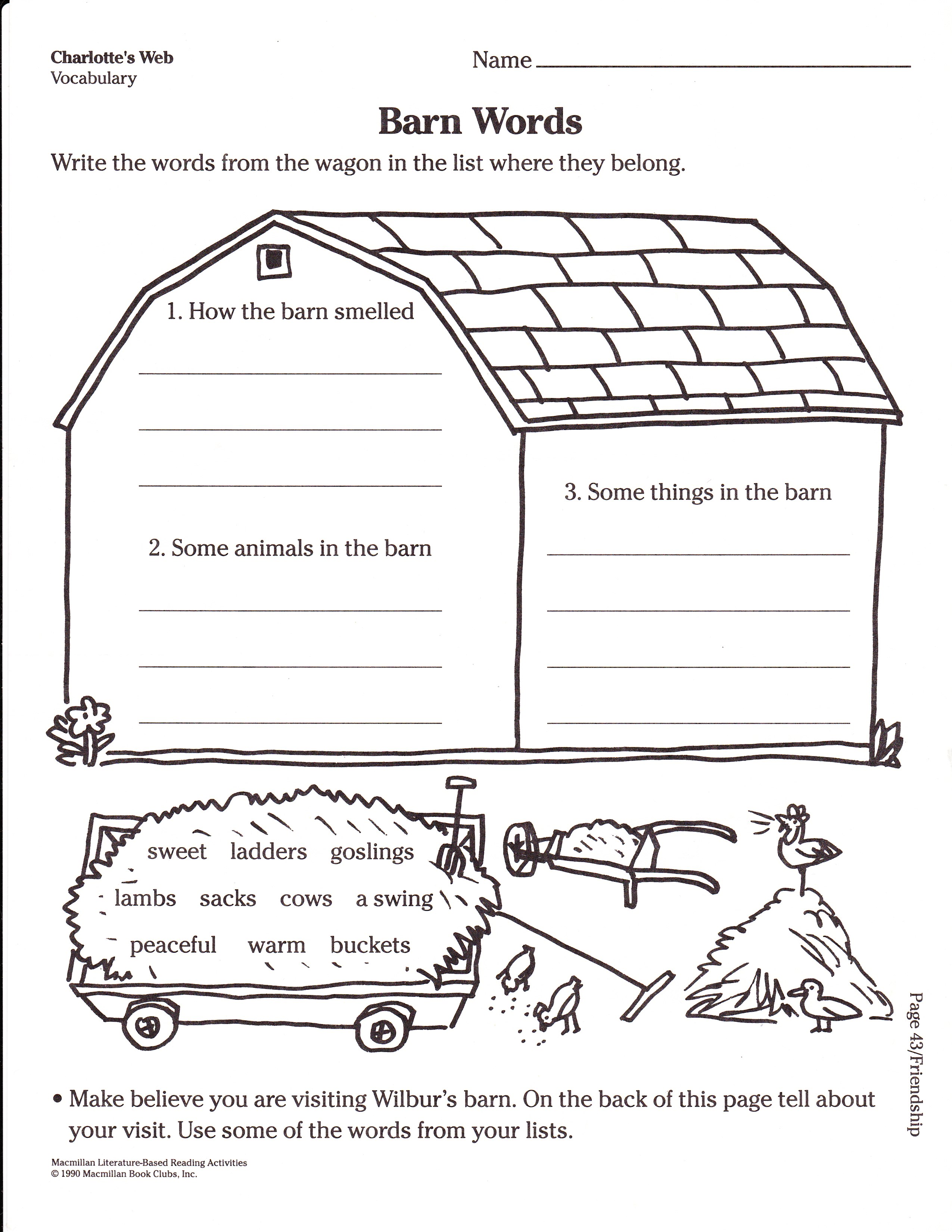
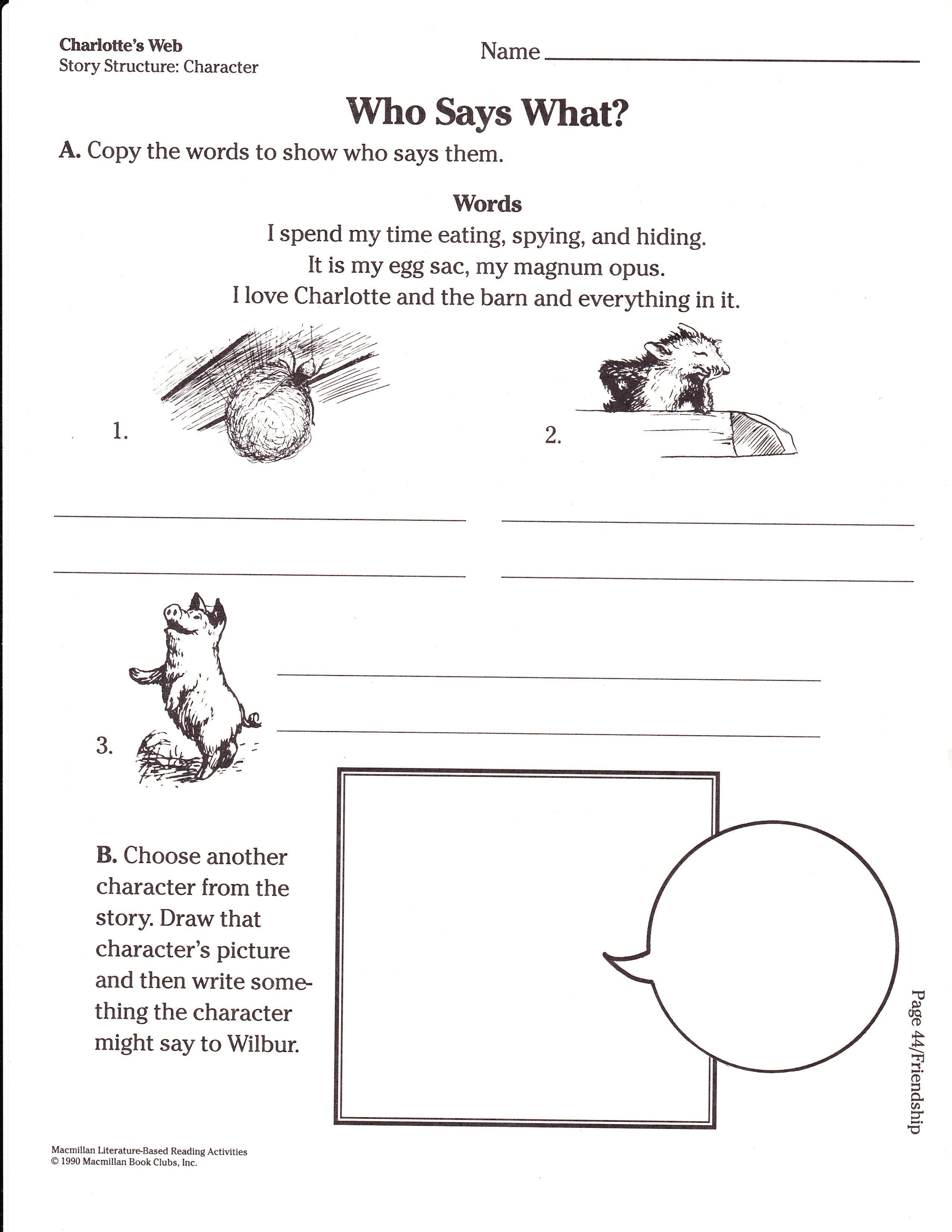
After reading the book or watching the movie, we might want to take a field trip to a farm or visit a friend who has a farm or farm animals. We will get to experience the physical sensory sensations as well as learn about all the new ideas and words associated with a working farm. On the car trip to the farm, we might play I Spy that naturally covers the writing exercise on the second sheet. Someone might draw the story or tell a similar story to their sibling for fun.
Overall, instead of these pre-planned activities, we’ve traded in staying indoors filling out more worksheets with being part of a real experience and learning first-hand from direct interaction while playing games on the way.
I could keep going but I think you get the idea. There is a shift at the core that can happen to help learning be more personal, relevant, and engaging. That said, if you had a resource like this and would like to take an idea or two out of it and offer it to your children, and you think it would be fun for them, and you approach it in an interesting way to your children, there’s nothing wrong with doing that. But, beware of trying to use a child’s interest to entice them to achieve our goals instead of theirs. It should be just extra, an opportunity to entice or inspire, and/or a bonding learning experience you want to share.
We don’t have to parse out and spoon feed bits of information to them. So much of learning can come directly from the personal reaction of each child to the input, stimulus, or experience, including books. It gets soaked in and discovered just by living it, exploring it, acting on what they feel inspired by it. If we provide an enriching environment, time to spend contemplating and exploring, access to real experiences outside and in the community, and availability to interact and discuss with them what’s on their minds, inspired open-ended individualized learning will naturally occur. What we need to do to help ourselves in this shift is to put on new eyes in which to view our children by developing keen observation skills. Pay attention to what you see your children do, what excites them, the little nuances to their play, or what they noticed that mattered to them. This is how all those meaningful learning traits found in the left-hand column will be born that will produce passionate, engaged, life-long learners.









Pingback: How to Shift From School Think to Engaged Learning – Bip on the Radar
Pingback: A Different Process and Product |